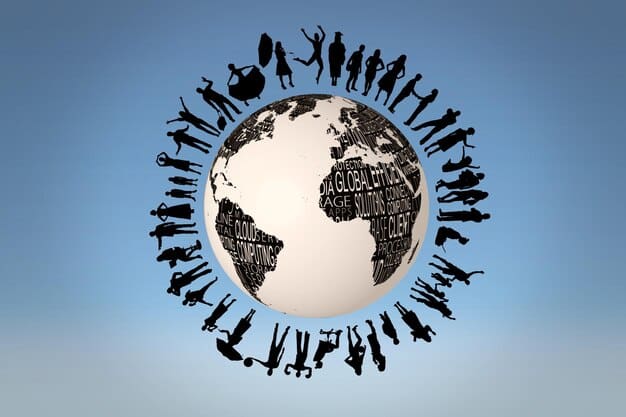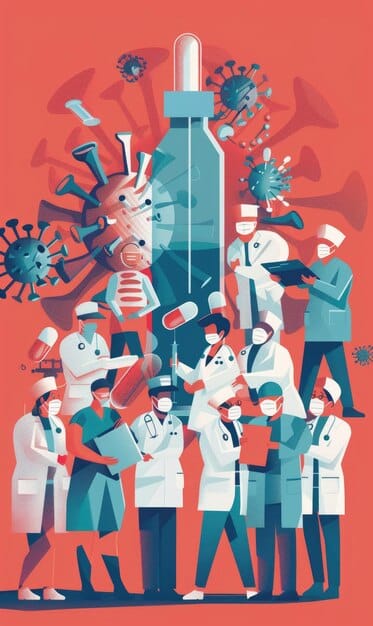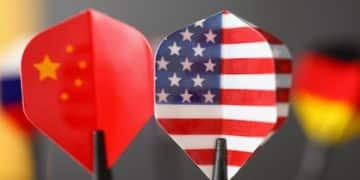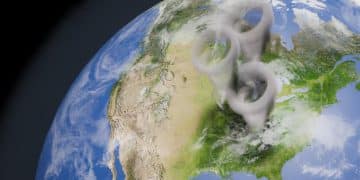The US and WHO: Current Ties and Future Hurdles Examined

The United States’ intricate relationship with the World Health Organization is continually shaped by shifting geopolitical landscapes and global health imperatives, presenting both challenges and opportunities for future cooperation.
The relationship between The US and the World Health Organization: Analyzing the Current Relationship and Future Challenges is a complex and evolving dynamic, central to global health governance. Understanding this intricate partnership requires a deep dive into its historical context, recent shifts, and the critical issues that define its trajectory.
The Foundational Ties: A Historical Perspective
The United States played a pivotal role in the very establishment of the World Health Organization (WHO) in 1948. Driven by a post-World War II vision of international cooperation and a recognition that disease knows no borders, American leadership was instrumental in crafting the WHO’s constitution and setting its initial agenda. This foundational period saw a strong alignment of interests, with the U.S. viewing the WHO as a vital mechanism for global disease surveillance, public health infrastructure development, and humanitarian aid.
For decades, the U.S. remained the largest financial contributor to the WHO, providing significant voluntary and assessed contributions. This financial leverage often translated into substantial influence over the organization’s programs, priorities, and leadership appointments. American scientific expertise and public health initiatives frequently informed WHO guidelines and global health campaigns, from polio eradication to smallpox elimination.
Early Engagements and Shared Objectives
In the mid-20th century, the shared objectives between the U.S. and WHO were clear: to combat infectious diseases, improve maternal and child health, and strengthen health systems worldwide. This era was characterized by a relatively stable and constructive partnership, despite occasional disagreements. The U.S. saw the WHO as an indispensable tool for projecting its humanitarian values and soft power globally, while the WHO benefited immensely from American financial support and technical expertise.
- Post-WWII commitment to global stability and health.
- Significant U.S. financial contributions and leadership in WHO’s formation.
- Collaboration on major disease eradication campaigns like smallpox.
Evolving Dynamics and Emerging Tensions
As global health challenges grew more complex and the international political landscape shifted, the relationship began to experience periodic strains. Debates over funding models, strategic priorities, and the WHO’s bureaucratic efficiency occasionally surfaced. However, despite these fluctuations, the underlying commitment to global health cooperation generally prevailed, highlighting the enduring importance of the partnership.
These early tensions, though minor, foreshadowed later, more significant disagreements, particularly concerning the WHO’s autonomy, its response to emerging health crises, and the influence of other rising global powers. The foundational ties, however, provided a resilient framework that allowed the relationship to weather many storms.
In summary, the historical context reveals a relationship rooted in shared ideals and mutual benefit, where the U.S. played a leading role in shaping the WHO’s mandate and operations, fostering an era of robust global health cooperation.
Recent Shifts and the Impact of the COVID-19 Pandemic
The turn of the 21st century brought new challenges that significantly altered the U.S.-WHO relationship, none more impactful than the COVID-19 pandemic. Before the pandemic, signs of strain were already evident, with U.S. administrations expressing concerns over the WHO’s perceived inefficiencies and influence from other member states.
However, the COVID-19 crisis dramatically escalated these tensions. The U.S. government, under the Trump administration, openly criticized the WHO’s initial response to the outbreak, accusing the organization of being too deferential to China and of mismanaging crucial early information. These criticisms culminated in the unprecedented decision to halt U.S. funding to the WHO and to initiate a process of withdrawal from the organization.
The Withdrawal and Re-engagement Cycles
The announcement of withdrawal sent shockwaves through the global health community, raising concerns about the future of international cooperation in a pandemic era. Proponents of the withdrawal argued that it was necessary to force reforms within the WHO and to protect U.S. sovereignty.
In January 2021, the incoming Biden administration immediately reversed the withdrawal decision, reaffirming the U.S.’s commitment to the WHO and multilateralism. This re-engagement was seen as a crucial step towards rebuilding trust and restoring American leadership in global health, though the path forward remains complex.
- Increased scrutiny of WHO’s autonomy and decision-making processes.
- U.S. concerns about China’s growing influence within the organization.
- Dramatic shift in U.S. policy from withdrawal to re-engagement.
Lessons Learned from the Pandemic Response
The pandemic exposed vulnerabilities in global health security and highlighted the indispensable role of the WHO, despite its shortcomings. Both the U.S. and the international community recognized the need for a stronger, more agile, and better-funded WHO. Discussions began on potential reforms, including enhanced pandemic preparedness, more transparent data sharing mechanisms, and a review of the International Health Regulations.
The experience underscored that global health threats demand global solutions, and unilateral actions can severely undermine collective efforts. While the U.S. re-engaged, the episode left lingering questions about the stability and predictability of U.S. foreign policy towards international organizations. The relationship is now characterized by a cautious optimism, combined with a shared understanding that reforms are necessary for both the U.S. and the WHO to effectively navigate future public health crises.

The recent shifts, particularly those instigated by the pandemic, have profoundly reshaped the dialogue, pushing both sides towards a more critical assessment of their roles and responsibilities in global health.
Critical Areas of Cooperation and Disagreement
Despite the recent strains, the U.S. and WHO continue to share many critical objectives in global health. Their cooperation spans a wide range of areas, from routine surveillance to complex humanitarian responses. However, significant points of disagreement also persist, often reflecting differing national interests and ideological perspectives.
Shared Priorities in Global Health
Both the U.S. and the WHO recognize that infectious diseases, antimicrobial resistance, and health system strengthening are global priorities. They collaborate on vaccine development and distribution, disease surveillance systems, and capacity building in low-income countries. Initiatives like the Global Fund to Fight AIDS, Tuberculosis and Malaria, actively supported by the U.S., often work in tandem with WHO guidelines and programs, underscoring areas of practical synergy.
Furthermore, climate change, non-communicable diseases, and access to essential medicines are growing areas where joint efforts are crucial. The U.S. brings invaluable scientific research, technological innovation, and financial resources to these endeavors, which are then amplified by the WHO’s global reach and normative functions.
Points of Contention and Divergent Views
Disagreements typically arise over several key issues. Funding remains a perennial flashpoint, with questions about the scale of U.S. contributions versus its demanded influence. There are also debates about the WHO’s governance structure, particularly regarding the balance of power among member states and the selection of leadership.
- Funding levels and the perceived return on investment for the U.S.
- WHO’s independence from political influence, especially from major powers.
- Effectiveness and efficiency of WHO’s bureaucratic processes.
Another area of friction involves intellectual property rights for medicines and vaccines, particularly during public health emergencies. The U.S., often advocating for pharmaceutical innovation, can find itself at odds with the WHO’s emphasis on equitable global access. Perceptions of the WHO’s political neutrality, especially concerning sensitive geopolitical issues, also frequently emerge as sources of tension.
Ultimately, while the operational level often sees ongoing cooperation, strategic disagreements at the policy level continue to shape the contours of the relationship. Bridging these divides requires sustained dialogue, mutual respect, and a willingness to compromise on both sides to achieve common global health goals.
Navigating Future Challenges: Strengthening and Reforming the WHO
Looking ahead, the U.S. and the WHO face numerous challenges, not least the imperative to prepare for the next global health crisis. The COVID-19 pandemic served as a stark reminder of the fragile state of global health security and the critical need for a robust, well-funded, and empowered WHO.
Proposals for WHO Reform
There is broad consensus among member states, including the U.S., that the WHO needs significant reforms to enhance its effectiveness and agility. Key proposals include strengthening its financial independence by increasing assessed contributions and reducing reliance on earmarked voluntary funding. This would give the WHO more flexibility to respond to unforeseen crises and pursue long-term strategic objectives.
Other reform elements focus on improving transparency, data-sharing mechanisms, and early warning systems for emerging pathogens. Efforts are underway to negotiate a new global pandemic treaty or accord, aiming to establish clearer rules and responsibilities for nations during health emergencies, including equitable access to vaccines and therapeutics. The U.S. is engaged in these discussions, advocating for a robust framework that reflects lessons learned from COVID-19.
The Role of U.S. Leadership and Engagement
The U.S. role in these reform efforts is crucial. As a major financial and scientific power, its sustained engagement and commitment are vital for the success of any substantive changes within the WHO. This involves not only financial contributions but also diplomatic leadership to foster consensus among a diverse array of member states. The U.S. can champion reforms that promote accountability, strengthen scientific independence, and ensure the WHO remains focused on its core public health mandate.
- Advocating for increased assessed contributions for greater financial stability.
- Promoting transparency and accountability within WHO’s operations.
- Supporting negotiations for a new global pandemic accord.
However, future challenges also include geopolitical competition, particularly with China, and the need to balance national sovereignty with global health cooperation. The U.S. will need to articulate a clear vision for its partnership with the WHO that goes beyond crisis response and addresses systemic vulnerabilities in global health governance.
Navigating these challenges requires a strategic and nuanced approach, one that acknowledges both the past difficulties and the undeniable necessity of a strong, multilateral health organization in an interconnected world.
The Geopolitical Landscape and its Influence
The relationship between the U.S. and the WHO cannot be fully understood in isolation; it is deeply intertwined with the broader geopolitical landscape. Major power dynamics and shifting global alliances increasingly influence how nations engage with international bodies like the WHO, creating both opportunities and obstacles for cooperation.
U.S.-China Relations and the WHO
The strained relationship between the U.S. and China has become a prominent factor impacting the WHO. Both nations are significant players in global health, but their different approaches to governance, transparency, and multilateralism often put them at odds within the organization. Concerns in the U.S. about China’s growing influence within the WHO have frequently been cited as a reason for American skepticism or withdrawal.
This geopolitical competition can complicate the WHO’s ability to act impartially and effectively, especially during crises where rapid information sharing and coordinated responses are paramount. The WHO often finds itself in a delicate balancing act, trying to maintain neutrality while navigating the competing interests of its most powerful member states.
Multilateralism vs. Unilateralism
The ongoing debate between multilateralism and unilateralism also shapes the U.S.-WHO relationship. Periods of U.S. foreign policy that favor unilateral action or bilateral agreements tend to diminish engagement with global bodies, potentially weakening the WHO’s authority and funding. Conversely, administrations that prioritize multilateral cooperation seek to strengthen these institutions, viewing them as essential for addressing transnational problems.
The current global environment, marked by rising nationalism and competition, poses a significant challenge to the principles of collective action that underpin the WHO. For the U.S., reconciling its national interests with the imperative of global health security within a multilateral framework is a continuous and complex undertaking.
The geopolitical context thus serves as a critical backdrop, influencing funding decisions, reform efforts, and the overall strategic direction of the U.S.-WHO partnership. Future stability in global health governance will depend heavily on how these broader power dynamics are managed.
The Future Path: Towards a More Resilient Partnership
The future of the U.S.-WHO relationship hinges on addressing past challenges while building a more resilient and effective partnership for global health security. Both sides recognize the need for a durable framework that transcends political cycles and responds robustly to emerging threats.
Rebuilding Trust and Ensuring Sustainability
A fundamental requirement for a stronger partnership is the rebuilding of trust. This involves consistent U.S. engagement, transparent communication, and a clear commitment to the WHO’s core mission. For its part, the WHO must demonstrate continued efforts towards reform, efficiency, and accountability, addressing concerns about its governance and operational procedures. Ensuring sustainable and predictable funding mechanisms is paramount. The U.S. can play a leading role in advocating for and contributing to a more diversified and robust financial base for the WHO, reducing its vulnerability to shifts in individual member state policies. This financial stability is crucial for the WHO to maintain its independence and long-term planning capabilities.
Moreover, active collaboration on scientific research and development, particularly for pandemic preparedness tools and equitable access strategies, will strengthen the operational ties. This could include joint initiatives on vaccine development, diagnostic rapid deployment, and health worker training, leveraging the strengths of both entities.
Adapting to New Global Health Realities
The health landscape is constantly evolving, with new threats like climate-related health impacts, increasing antimicrobial resistance, and growing mental health crises. The U.S. and the WHO must adapt their partnership to these new realities. This means moving beyond a sole focus on infectious diseases to encompass a broader spectrum of public health challenges that require integrated, multi-sectoral approaches. Developing innovative strategies for health equity, especially in marginalized communities globally, also needs to be a central pillar of future cooperation.
- Commitment to consistent U.S. engagement and diplomatic leadership.
- WHO’s continued efforts towards transparency and operational efficiency.
- Development of a diversified and stable funding model for the WHO.
- Focus on equitable access to health resources and climate-related health impacts.
Ultimately, a resilient partnership will be one that learns from past lessons, proactively addresses future challenges, and maintains a shared vision of a healthier, more secure world. The stakes are too high for either the U.S. or the WHO to falter in this indispensable collaboration.
The trajectory of the U.S.-WHO relationship signals a critical moment for global health governance, requiring strategic foresight and unwavering commitment from all stakeholders.
| Key Point | Brief Description |
|---|---|
| 🤝 Historical Role | U.S. was central to WHO’s founding and early funding, shaping global health priorities. |
| ⚡ COVID-19 Impact | Pandemic led to U.S. withdrawal then swift re-engagement, highlighting critical interdependencies. |
| 🔍 Challenges & Reforms | Debates on funding, governance, and the need for new pandemic treaties dominate discussions. |
| 🌐 Geopolitical Influence | U.S.-China relations and multilateralism debates significantly impact WHO’s operational space. |
Frequently Asked Questions About the U.S. and WHO
The U.S. was a driving force behind the creation of the WHO in 1948, advocating for a global health body to address disease internationally. Its strong leadership and financial contributions were instrumental in shaping the organization’s initial mandate and structure, paving the way for decades of cooperation on public health initiatives.
The COVID-19 pandemic dramatically strained the relationship, leading to a U.S. decision to halt funding and initiate withdrawal under the Trump administration. However, the Biden administration promptly rejoined, underscoring the critical need for global health cooperation even amidst disagreements regarding the WHO’s initial crisis response.
Currently, key cooperation areas include combating infectious diseases, strengthening global health security, promoting vaccine development and equitable distribution, and improving health systems worldwide. Both entities also collaborate on addressing emerging threats like antimicrobial resistance and the health impacts of climate change, sharing scientific expertise and resources.
Future challenges include navigating geopolitical competition, particularly with China, reforming WHO’s funding and governance to ensure stability and independence, and negotiating a new global pandemic accord. The relationship must also adapt to new global health demands beyond infectious diseases, such as mental health and non-communicable diseases.
Strengthening the WHO requires increased assessed contributions for financial independence, improved transparency, and robust data-sharing mechanisms. Reforming its early warning systems, enhancing its ability to investigate outbreaks swiftly, and establishing a binding global pandemic treaty are also crucial steps for a more resilient and effective organization.
Conclusion
The relationship between the United States and the World Health Organization is a dynamic and essential partnership, fundamental to addressing global health challenges. Despite historical fluctuations and recent tensions, particularly during the COVID-19 pandemic, both entities acknowledge the indispensable need for ongoing cooperation. The path forward involves sustained U.S. engagement, a commitment to WHO reforms that enhance its financial stability and operational efficiency, and a shared resolve to build a more resilient global health architecture. Effectively navigating future pandemics, climate-related health crises, and other evolving threats hinges on fostering trust, bridging policy disagreements, and prioritizing collective action over unilateral interests. The future stability of global health security rests significantly on the strength and evolution of this critical bilateral-multilateral relationship.





